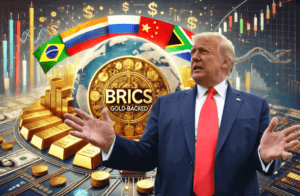BRICS Currency: Trump Issues Ultimatum
President Donald Trump has repeatedly threatened BRICS member states with imposing a 100% tariff on their imports to the United States if they persist with efforts to create a reserve currency to rival the US dollar.
Trump had made a similar statement against BRICS currency plan right after winning the November 2024 elections.
According to Trump, there was “no chance” that BRICS would replace the US dollar in international trade. He also stated that “any country that tries should say hello to tariffs, and goodbye to America!”
Why BRICS Want to Challenge the US Dollar
BRICS represents nearly half of the world’s population and is considered as a counterpart to the G7 group of countries.
The BRICS nations—named after original members Brazil, Russia, India, China, and South Africa—are among the fastest-growing economies. The group is eager to reduce its reliance on the US dollar, the world’s reserve currency, which accounts for nearly 80% of global trade.
The dollar-dominated financial system gives the United States significant economic advantages. These include lower borrowing costs, the ability to maintain massive fiscal deficits and exchange-rate resilience.
The dollar is the primary currency to price commodities like oil and gold. Thus, its stability means investors often flock to the dollar during uncertain times.
Washington also benefits from enormous geopolitical influence from so-dollarization. These include the ability to impose sanctions on other countries and restrict their access to trade and capital.
BRICS expanded in 2024 to include Iran, Egypt, Ethiopia and the United Arab Emirates. Indonesia became member in January.
They have accused the US of “weaponizing” the dollar, leveraging the currency so that competitors must operate within a framework defined by US interests.
Discussions about a new joint currency gained traction after the US and European Union imposed sanctions on Russia over its 2022 invasion of Ukraine. The fear is that BRICS nations could be targeted if they fell out with the West.
In general, the outsized role of the US dollar in the world economy has strengthened of late, thanks to the robust US economy, tighter monetary policy, and heightened geopolitical risks, even as economic fragmentation has boosted a push by BRICS countries to shift away from the dollar into other currencies.

BRICS Currency Plan
The creation of a BRICS currency was first discussed following the 2008/9 financial crisis.
At the 2023 BRICS summit in South Africa, the bloc agreed to study the possibility of creating a common currency to reduce its exposure to dollar-related risks. However, BRICS leaders noted that this would likely take years to realize.
In October 2024, Russia’s President Vladimir Putin went further during a BRICS summit in Kazan to propose a blockchain-based international payments system. This system will be able to circumvent Western sanctions.
Putin’s plan was not widely believed. Still, BRICS leaders agreed to facilitate more trade in local currencies, reducing their reliance on the dollar.
Putin and Brazil’s president, Luiz Inacio Lula da Silva, are the strongest proponents of the new currency. However, China has not explicitly expressed a view but has supported initiatives to reduce reliance on the dollar. Meanwhile, India is a lot more cautious about the idea.
Trump now wants to kill off the BRICS currency plan.
Feasibility of a Common Currency
A new joint currency would be a massive undertaking for BRICS nations. The idea is fraught with many complexities due to the differing political and economic systems within the nine current members. The BRICS states are at various stages of economic development and have considerably different growth rates.
China, for example, is an autocratic state but is responsible for about 70% of the bloc’s GDP at $17.8 trillion (€17 trillion). Also, China runs a trade surplus and maintains a large holding of dollars to support its competitiveness as a major exporter. On the other hand, India runs a trade deficit, is the world’s largest democracy, and has an economy worth $3.7 trillion.
As a result, China’s dominance in BRICS would create a tremendous imbalance that would make it hard for India to agree on a new currency framework that may overshadow national interests. Thus, differences between other BRICS members will likely trigger resistance to a shared currency.
BRICS Dollar Alternative
It’s also unlikely that the BRICS members want to eventually move toward a fully traded currency, like the euro or dollar. The euro took more than 40 years to come into effect, from 1959, when it was first discussed, until 2002, when its coins & notes became a legal currency within the eurozone member states.
Therefore, the most likely option would be creating a joint currency used purely for trade, valued based on a basket of currencies and/or commodities like gold or oil.
It could function similarly to the International Monetary Fund’s Special Drawing Rights (SDR). The SDR is an international financial asset valued at the daily exchange rates of the dollar, euro, yuan, yen, and pound. Others have suggested a digital currency



